David R. Michael's Blog, page 3
November 12, 2019
The Very Hungry Zombie
 The Very Hungry Zombie
The Very Hungry Zombie
by David R. Michael
Beware the very hungry zombie!
A counting book for the zombie apocalypse.
Free Preview!
.wds_slider_0 video::-webkit-media-controls-panel { display: none!important; -webkit-appearance: none; } .wds_slider_0 video::--webkit-media-controls-play-button { display: none!important; -webkit-appearance: none; } .wds_slider_0 video::-webkit-media-controls-start-playback-button { display: none!important; -webkit-appearance: none; } .wds_bigplay_0, .wds_slideshow_image_0, .wds_slideshow_video_0 { display: block; } .wds_bulframe_0 { display: none; background-image: url(''); margin: 0px; position: absolute; z-index: 3; -webkit-transition: left 1s, right 1s; transition: left 1s, right 1s; width: 30%; height: 30%; } #wds_container1_0 #wds_container2_0 { margin: 0px ; text-align: center; visibility: hidden; } #wds_container1_0 #wds_container2_0 .wds_slideshow_image_wrap_0, #wds_container1_0 #wds_container2_0 .wds_slideshow_image_wrap_0 * { box-sizing: border-box; -moz-box-sizing: border-box; -webkit-box-sizing: border-box; } #wds_container1_0 #wds_container2_0 .wds_slideshow_image_wrap_0 { background-color: rgba(0, 0, 0, 0.00); border-width: 0px; border-style: none; border-color: #000000; border-radius: ; border-collapse: collapse; display: inline-block; position: relative; text-align: center; width: 100%; box-shadow: ; overflow: hidden; z-index: 0; } #wds_container1_0 #wds_container2_0 .wds_slideshow_image_0 { width: 100%; height: 100%; float: none !important; padding: 0 !important; margin: 0 !important; vertical-align: middle; } #wds_container1_0 #wds_container2_0 .wds_slideshow_image_0 video { padding: 0 !important; margin: 0 !important; vertical-align: middle; background-position: center center; background-repeat: no-repeat; } #wds_container1_0 #wds_container2_0 .wds_slideshow_image_container_0 { display: /*table*/block; position: absolute; text-align: center; vertical-align: middle; width: 100%; height: 100%; } @media only screen and (min-width: 0px) and (max-width: 320px) { .wds_bigplay_0, .wds_bigplay_layer { position: absolute; width: 20px; height: 20px; background-image: url('http://www.gunsandmagic.com/wp-conten... background-position: center center; background-repeat: no-repeat; background-size: cover; transition: background-image 0.2s ease-out; -ms-transition: background-image 0.2s ease-out; -moz-transition: background-image 0.2s ease-out; -webkit-transition: background-image 0.2s ease-out; top: 0; left: 0; right: 0; bottom: 0; margin: auto } .wds_bigplay_0:hover, .wds_bigplay_layer:hover { background: url('http://www.gunsandmagic.com/wp-conten...') no-repeat; width: 20px; height: 20px; background-position: center center; background-repeat: no-repeat; background-size: cover; } #wds_container1_0 #wds_container2_0 .wds_slideshow_dots_thumbnails_0 { height: 16px; width: 384px; } #wds_container1_0 #wds_container2_0 .wds_slideshow_dots_0 { font-size: 12px; margin: 2px; width: 12px; height: 12px; } #wds_container1_0 #wds_container2_0 .wds_pp_btn_cont { font-size: 20px; height: 20px; width: 20px; } #wds_container1_0 #wds_container2_0 .wds_left_btn_cont, #wds_container1_0 #wds_container2_0 .wds_right_btn_cont { height: 20px; font-size: 20px; width: 20px; } } @media only screen and (min-width: 321px) and (max-width: 480px) { .wds_bigplay_0, .wds_bigplay_layer { position: absolute; width: 30px; height: 30px; background-image: url('http://www.gunsandmagic.com/wp-conten... background-position: center center; background-repeat: no-repeat; background-size: cover; transition: background-image 0.2s ease-out; -ms-transition: background-image 0.2s ease-out; -moz-transition: background-image 0.2s ease-out; -webkit-transition: background-image 0.2s ease-out; top: 0; left: 0; right: 0; bottom: 0; margin: auto } .wds_bigplay_0:hover, .wds_bigplay_layer:hover { background: url('http://www.gunsandmagic.com/wp-conten...') no-repeat; width: 30px; height: 30px; background-position: center center; background-repeat: no-repeat; background-size: cover; } #wds_container1_0 #wds_container2_0 .wds_slideshow_dots_thumbnails_0 { height: 22px; width: 528px; } #wds_container1_0 #wds_container2_0 .wds_slideshow_dots_0 { font-size: 18px; margin: 2px; width: 18px; height: 18px; } #wds_container1_0 #wds_container2_0 .wds_pp_btn_cont { font-size: 30px; height: 30px; width: 30px; } #wds_container1_0 #wds_container2_0 .wds_left_btn_cont, #wds_container1_0 #wds_container2_0 .wds_right_btn_cont { height: 30px; font-size: 30px; width: 30px; } } @media only screen and (min-width: 481px) and (max-width: 640px) { .wds_bigplay_0, .wds_bigplay_layer { position: absolute; width: 40px; height: 40px; background-image: url('http://www.gunsandmagic.com/wp-conten... background-position: center center; background-repeat: no-repeat; background-size: cover; transition: background-image 0.2s ease-out; -ms-transition: background-image 0.2s ease-out; -moz-transition: background-image 0.2s ease-out; -webkit-transition: background-image 0.2s ease-out; top: 0; left: 0; right: 0; bottom: 0; margin: auto } .wds_bigplay_0:hover, .wds_bigplay_layer:hover { background: url('http://www.gunsandmagic.com/wp-conten...') no-repeat; width: 40px; height: 40px; background-position: center center; background-repeat: no-repeat; background-size: cover; } #wds_container1_0 #wds_container2_0 .wds_slideshow_dots_thumbnails_0 { height: 26px; width: 624px; } #wds_container1_0 #wds_container2_0 .wds_slideshow_dots_0 { font-size: 20px; margin: 3px; width: 20px; height: 20px; } #wds_container1_0 #wds_container2_0 .wds_pp_btn_cont { font-size: 40px; height: 40px; width: 40px; } #wds_container1_0 #wds_container2_0 .wds_left_btn_cont, #wds_container1_0 #wds_container2_0 .wds_right_btn_cont { height: 40px; font-size: 40px; width: 40px; } } @media only screen and (min-width: 641px) and (max-width: 768px) { .wds_bigplay_0, .wds_bigplay_layer { position: absolute; width: 40px; height: 40px; background-image: url('http://www.gunsandmagic.com/wp-conten... background-position: center center; background-repeat: no-repeat; background-size: cover; transition: background-image 0.2s ease-out; -ms-transition: background-image 0.2s ease-out; -moz-transition: background-image 0.2s ease-out; -webkit-transition: background-image 0.2s ease-out; top: 0; left: 0; right: 0; bottom: 0; margin: auto } .wds_bigplay_0:hover, .wds_bigplay_layer:hover { background: url('http://www.gunsandmagic.com/wp-conten...') no-repeat; width: 40px; height: 40px; background-position: center center; background-repeat: no-repeat; background-size: cover; } #wds_container1_0 #wds_container2_0 .wds_slideshow_dots_thumbnails_0 { height: 26px; width: 624px; } #wds_container1_0 #wds_container2_0 .wds_slideshow_dots_0 { font-size: 20px; margin: 3px; width: 20px; height: 20px; } #wds_container1_0 #wds_container2_0 .wds_pp_btn_cont { font-size: 40px; height: 40px; width: 40px; } #wds_container1_0 #wds_container2_0 .wds_left_btn_cont, #wds_container1_0 #wds_container2_0 .wds_right_btn_cont { height: 40px; font-size: 40px; width: 40px; } } @media only screen and (min-width: 769px) and (max-width: 800px) { .wds_bigplay_0, .wds_bigplay_layer { position: absolute; width: 40px; height: 40px; background-image: url('http://www.gunsandmagic.com/wp-conten... background-position: center center; background-repeat: no-repeat; background-size: cover; transition: background-image 0.2s ease-out; -ms-transition: background-image 0.2s ease-out; -moz-transition: background-image 0.2s ease-out; -webkit-transition: background-image 0.2s ease-out; top: 0; left: 0; right: 0; bottom: 0; margin: auto } .wds_bigplay_0:hover, .wds_bigplay_layer:hover { background: url('http://www.gunsandmagic.com/wp-conten...') no-repeat; width: 40px; height: 40px; background-position: center center; background-repeat: no-repeat; background-size: cover; } #wds_container1_0 #wds_container2_0 .wds_slideshow_dots_thumbnails_0 { height: 26px; width: 624px; } #wds_container1_0 #wds_container2_0 .wds_slideshow_dots_0 { font-size: 20px; margin: 3px; width: 20px; height: 20px; } #wds_container1_0 #wds_container2_0 .wds_pp_btn_cont { font-size: 40px; height: 40px; width: 40px; } #wds_container1_0 #wds_container2_0 .wds_left_btn_cont, #wds_container1_0 #wds_container2_0 .wds_right_btn_cont { height: 40px; font-size: 40px; width: 40px; } } @media only screen and (min-width: 801px) and (max-width: 1024px) { .wds_bigplay_0, .wds_bigplay_layer { position: absolute; width: 40px; height: 40px; background-image: url('http://www.gunsandmagic.com/wp-conten... background-position: center center; background-repeat: no-repeat; background-size: cover; transition: background-image 0.2s ease-out; -ms-transition: background-image 0.2s ease-out; -moz-transition: background-image 0.2s ease-out; -webkit-transition: background-image 0.2s ease-out; top: 0; left: 0; right: 0; bottom: 0; margin: auto } .wds_bigplay_0:hover, .wds_bigplay_layer:hover { background: url('http://www.gunsandmagic.com/wp-conten...') no-repeat; width: 40px; height: 40px; background-position: center center; background-repeat: no-repeat; background-size: cover; } #wds_container1_0 #wds_container2_0 .wds_slideshow_dots_thumbnails_0 { height: 26px; width: 624px; } #wds_container1_0 #wds_container2_0 .wds_slideshow_dots_0 { font-size: 20px; margin: 3px; width: 20px; height: 20px; } #wds_container1_0 #wds_container2_0 .wds_pp_btn_cont { font-size: 40px; height: 40px; width: 40px; } #wds_container1_0 #wds_container2_0 .wds_left_btn_cont, #wds_container1_0 #wds_container2_0 .wds_right_btn_cont { height: 40px; font-size: 40px; width: 40px; } } @media only screen and (min-width: 1025px) and (max-width: 1366px) { .wds_bigplay_0, .wds_bigplay_layer { position: absolute; width: 40px; height: 40px; background-image: url('http://www.gunsandmagic.com/wp-conten... background-position: center center; background-repeat: no-repeat; background-size: cover; transition: background-image 0.2s ease-out; -ms-transition: background-image 0.2s ease-out; -moz-transition: background-image 0.2s ease-out; -webkit-transition: background-image 0.2s ease-out; top: 0; left: 0; right: 0; bottom: 0; margin: auto } .wds_bigplay_0:hover, .wds_bigplay_layer:hover { background: url('http://www.gunsandmagic.com/wp-conten...') no-repeat; width: 40px; height: 40px; background-position: center center; background-repeat: no-repeat; background-size: cover; } #wds_container1_0 #wds_container2_0 .wds_slideshow_dots_thumbnails_0 { height: 26px; width: 624px; } #wds_container1_0 #wds_container2_0 .wds_slideshow_dots_0 { font-size: 20px; margin: 3px; width: 20px; height: 20px; } #wds_container1_0 #wds_container2_0 .wds_pp_btn_cont { font-size: 40px; height: 40px; width: 40px; } #wds_container1_0 #wds_container2_0 .wds_left_btn_cont, #wds_container1_0 #wds_container2_0 .wds_right_btn_cont { height: 40px; font-size: 40px; width: 40px; } } @media only screen and (min-width: 1367px) and (max-width: 1824px) { .wds_bigplay_0, .wds_bigplay_layer { position: absolute; width: 40px; height: 40px; background-image: url('http://www.gunsandmagic.com/wp-conten... background-position: center center; background-repeat: no-repeat; background-size: cover; transition: background-image 0.2s ease-out; -ms-transition: background-image 0.2s ease-out; -moz-transition: background-image 0.2s ease-out; -webkit-transition: background-image 0.2s ease-out; top: 0; left: 0; right: 0; bottom: 0; margin: auto } .wds_bigplay_0:hover, .wds_bigplay_layer:hover { background: url('http://www.gunsandmagic.com/wp-conten...') no-repeat; width: 40px; height: 40px; background-position: center center; background-repeat: no-repeat; background-size: cover; } #wds_container1_0 #wds_container2_0 .wds_slideshow_dots_thumbnails_0 { height: 26px; width: 624px; } #wds_container1_0 #wds_container2_0 .wds_slideshow_dots_0 { font-size: 20px; margin: 3px; width: 20px; height: 20px; } #wds_container1_0 #wds_container2_0 .wds_pp_btn_cont { font-size: 40px; height: 40px; width: 40px; } #wds_container1_0 #wds_container2_0 .wds_left_btn_cont, #wds_container1_0 #wds_container2_0 .wds_right_btn_cont { height: 40px; font-size: 40px; width: 40px; } } @media only screen and (min-width: 1825px) and (max-width: 3000px) { .wds_bigplay_0, .wds_bigplay_layer { position: absolute; width: 40px; height: 40px; background-image: url('http://www.gunsandmagic.com/wp-conten... background-position: center center; background-repeat: no-repeat; background-size: cover; transition: background-image 0.2s ease-out; -ms-transition: background-image 0.2s ease-out; -moz-transition: background-image 0.2s ease-out; -webkit-transition: background-image 0.2s ease-out; top: 0; left: 0; right: 0; bottom: 0; margin: auto } .wds_bigplay_0:hover, .wds_bigplay_layer:hover { background: url('http://www.gunsandmagic.com/wp-conten...') no-repeat; width: 40px; height: 40px; background-position: center center; background-repeat: no-repeat; background-size: cover; } #wds_container1_0 #wds_container2_0 .wds_slideshow_dots_thumbnails_0 { height: 26px; width: 624px; } #wds_container1_0 #wds_container2_0 .wds_slideshow_dots_0 { font-size: 20px; margin: 3px; width: 20px; height: 20px; } #wds_container1_0 #wds_container2_0 .wds_pp_btn_cont { font-size: 40px; height: 40px; width: 40px; } #wds_container1_0 #wds_container2_0 .wds_left_btn_cont, #wds_container1_0 #wds_container2_0 .wds_right_btn_cont { height: 40px; font-size: 40px; width: 40px; } } #wds_container1_0 #wds_container2_0 .wds_slideshow_video_0 { padding: 0 !important; margin: 0 !important; float: none !important; height: 100%; width: 100%; vertical-align: middle; display: inline-block; } #wds_container1_0 #wds_container2_0 #wds_slideshow_play_pause_0 { color: #000000; cursor: pointer; position: relative; z-index: 13; width: inherit; height: inherit; font-size: inherit; } #wds_container1_0 #wds_container2_0 #wds_slideshow_play_pause_0:hover { color: #000000; cursor: pointer; } #wds_container1_0 #wds_container2_0 .wds_left-ico_0, #wds_container1_0 #wds_container2_0 .wds_right-ico_0 { background-color: rgba(255, 255, 255, 0.00); border-radius: 20px; border: 0px none #FFFFFF; border-collapse: separate; color: #000000; left: 0; top: 0; -moz-box-sizing: content-box; box-sizing: content-box; cursor: pointer; line-height: 0; width: inherit; height: inherit; font-size: inherit; position: absolute; } #wds_container1_0 #wds_container2_0 .wds_left-ico_0 { left: -4000px; } #wds_container1_0 #wds_container2_0 .wds_right-ico_0 { left: 4000px; } #wds_container1_0 #wds_container2_0 #wds_slideshow_play_pause_0 { opacity: 0; filter: "Alpha(opacity=0)"; } #wds_container1_0 #wds_container2_0 .wds_left-ico_0:hover, #wds_container1_0 #wds_container2_0 .wds_right-ico_0:hover { color: #000000; cursor: pointer; } /* Filmstrip*/ #wds_container1_0 #wds_container2_0 .wds_slideshow_filmstrip_container_0 { background-color: #000000 !important; display: block; height: 0%; position: absolute; width: 100%; z-index: 10105; none: 0; overflow: hidden; } #wds_container1_0 #wds_container2_0 .wds_slideshow_filmstrip_0 { overflow: hidden; position: absolute; height: 100%; width: 0%; } #wds_container1_0 #wds_container2_0 .wds_slideshow_filmstrip_thumbnails_0 { height: 100%; left: 0px; margin: 0 auto; overflow: hidden; position: relative; width: 100%; } #wds_container1_0 #wds_container2_0 .wds_slideshow_filmstrip_thumbnail_0 { position: relative; background: none; float: left; height: 100%; padding: 0 0 0 0px; width: 0%; overflow: hidden; cursor: pointer; } #wds_container1_0 #wds_container2_0 .wds_slideshow_filmstrip_thumbnail_0 :active{ cursor: inherit; } #wds_container1_0 #wds_container2_0 #wds_filmstrip_thumbnail_0_0 { margin-left: 0; } #wds_container1_0 #wds_container2_0 .wds_slideshow_thumb_active_0 div { opacity: 1; filter: Alpha(opacity=100); border: 0px none #FFFFFF; } #wds_container1_0 #wds_container2_0 .wds_slideshow_thumb_deactive_0 { opacity: 0.50; filter: Alpha(opacity=50); } #wds_container1_0 #wds_container2_0 .wds_slideshow_filmstrip_thumbnail_img_0 { display: block; opacity: 1; filter: Alpha(opacity=100); padding: 0 !important; background-position: center center; background-repeat: no-repeat; background-size: cover; width: 100%; height: 100%; } #wds_container1_0 #wds_container2_0 .wds_slideshow_filmstrip_left_0, #wds_container1_0 #wds_container2_0 .wds_slideshow_filmstrip_right_0 { background-color: rgba(0, 0, 0, 0); cursor: pointer; display: table; vertical-align: middle; width: 20px; z-index: 10000; position: absolute; height: 100%; } #wds_container1_0 #wds_container2_0 .wds_slideshow_filmstrip_left_0 { left: 0; } #wds_container1_0 #wds_container2_0 .wds_slideshow_filmstrip_right_0 { right: 0; } #wds_container1_0 #wds_container2_0 .wds_slideshow_filmstrip_left_0 i, #wds_container1_0 #wds_container2_0 .wds_slideshow_filmstrip_right_0 i { color: #fff; display: table-cell; font-size: 30px; vertical-align: middle; opacity: 0; filter: Alpha(opacity=0); } #wds_container1_0 #wds_container2_0 .wds_none_selectable_0 { -webkit-touch-callout: none; -webkit-user-select: none; -khtml-user-select: none; -moz-user-select: none; -ms-user-select: none; user-select: none; } #wds_container1_0 #wds_container2_0 .wds_slide_container_0 { display: table-cell; margin: 0 auto; position: absolute; vertical-align: middle; width: 100%; height: 100%; overflow: hidden; cursor: inherit; cursor: inherit; cursor: inherit; } #wds_container1_0 #wds_container2_0 .wds_slide_container_0:active { cursor: inherit; cursor: inherit; cursor: inherit; } #wds_container1_0 #wds_container2_0 .wds_slide_bg_0 { margin: 0 auto; width: /*inherit*/100%; height: /*inherit*/100%; } #wds_container1_0 #wds_container2_0 .wds_slider_0 { height: /*inherit*/100%; width: /*inherit*/100%; } #wds_container1_0 #wds_container2_0 .wds_slideshow_image_spun_0 { width: /*inherit*/100%; height: /*inherit*/100%; display: table-cell; filter: Alpha(opacity=100); opacity: 1; position: absolute; vertical-align: middle; z-index: 2; } #wds_container1_0 #wds_container2_0 .wds_slideshow_image_second_spun_0 { width: /*inherit*/100%; height: /*inherit*/100%; display: table-cell; filter: Alpha(opacity=0); opacity: 0; position: absolute; vertical-align: middle; z-index: 1; } #wds_container1_0 #wds_container2_0 .wds_grid_0 { display: none; height: 100%; overflow: hidden; position: absolute; width: 100%; } #wds_container1_0 #wds_container2_0 .wds_gridlet_0 { opacity: 1; filter: Alpha(opacity=100); position: absolute; } /* Dots.*/ #wds_container1_0 #wds_container2_0 .wds_slideshow_dots_container_0 { opacity: 1; filter: "Alpha(opacity=100)"; } #wds_container1_0 #wds_container2_0 .wds_slideshow_dots_container_0 { display: block; overflow: hidden; position: absolute; width: 100%; none: 0; /*z-index: 17;*/ } #wds_container1_0 #wds_container2_0 .wds_slideshow_dots_thumbnails_0 { left: 0px; font-size: 0; margin: 0 auto; position: relative; z-index: 999; } #wds_container1_0 #wds_container2_0 .wds_slideshow_dots_0 { display: inline-block; position: relative; color: #FFFFFF; cursor: pointer; z-index: 17; } #wds_container1_0 #wds_container2_0 .wds_slideshow_dots_active_0 { color: #FFFFFF; opacity: 1; filter: Alpha(opacity=100); } #wds_container1_0 #wds_container2_0 .wds_slideshow_dots_deactive_0 { } #wds_container1_0 #wds_container2_0 .wds_slide_container_0 { height: /*inherit*/100%; } #wds_container1_0 #wds_container2_0 .wds_slideshow_image_spun1_0 { display: table; width: /*inherit*/100%; height: /*inherit*/100%; } #wds_container1_0 #wds_container2_0 .wds_slideshow_image_spun2_0 { display: table-cell; vertical-align: middle; text-align: center; overflow: hidden; height: /*inherit*/100%; } #wds_container1_0 #wds_container2_0 .wds_video_layer_frame_0 { max-height: 100%; max-width: 100%; width: 100%; height: 100%; } #wds_container1_0 #wds_container2_0 .wds_video_hide0 { width: 100%; height: 100%; position:absolute; } #wds_container1_0 #wds_container2_0 .wds_slider_car_image0 { overflow: hidden; } #wds_container1_0 .wds_loading_img { background-image: url('http://www.gunsandmagic.com/wp-conten... } #wds_container1_0 #wds_container2_0 #wds_image_id_0_4 .wds_slideshow_image_0 { background-size: cover; background-position: center center; background-repeat: no-repeat; } #wds_container1_0 #wds_container2_0 #wds_image_id_0_4 .wds_slideshow_image_0 > video { background-size: cover; } #wds_container1_0 #wds_container2_0 #wds_image_id_0_5 .wds_slideshow_image_0 { background-size: cover; background-position: center center; background-repeat: no-repeat; } #wds_container1_0 #wds_container2_0 #wds_image_id_0_5 .wds_slideshow_image_0 > video { background-size: cover; } #wds_container1_0 #wds_container2_0 #wds_image_id_0_6 .wds_slideshow_image_0 { background-size: cover; background-position: center center; background-repeat: no-repeat; } #wds_container1_0 #wds_container2_0 #wds_image_id_0_6 .wds_slideshow_image_0 > video { background-size: cover; } #wds_container1_0 #wds_container2_0 #wds_image_id_0_7 .wds_slideshow_image_0 { background-size: cover; background-position: center center; background-repeat: no-repeat; } #wds_container1_0 #wds_container2_0 #wds_image_id_0_7 .wds_slideshow_image_0 > video { background-size: cover; } #wds_container1_0 #wds_container2_0 #wds_image_id_0_8 .wds_slideshow_image_0 { background-size: cover; background-position: center center; background-repeat: no-repeat; } #wds_container1_0 #wds_container2_0 #wds_image_id_0_8 .wds_slideshow_image_0 > video { background-size: cover; } #wds_container1_0 #wds_container2_0 #wds_image_id_0_9 .wds_slideshow_image_0 { background-size: cover; background-position: center center; background-repeat: no-repeat; } #wds_container1_0 #wds_container2_0 #wds_image_id_0_9 .wds_slideshow_image_0 > video { background-size: cover; } #wds_container1_0 #wds_container2_0 #wds_image_id_0_10 .wds_slideshow_image_0 { background-size: cover; background-position: center center; background-repeat: no-repeat; } #wds_container1_0 #wds_container2_0 #wds_image_id_0_10 .wds_slideshow_image_0 > video { background-size: cover; } #wds_container1_0 #wds_container2_0 #wds_image_id_0_11 .wds_slideshow_image_0 { background-size: cover; background-position: center center; background-repeat: no-repeat; } #wds_container1_0 #wds_container2_0 #wds_image_id_0_11 .wds_slideshow_image_0 > video { background-size: cover; } #wds_container1_0 #wds_container2_0 #wds_image_id_0_12 .wds_slideshow_image_0 { background-size: cover; background-position: center center; background-repeat: no-repeat; } #wds_container1_0 #wds_container2_0 #wds_image_id_0_12 .wds_slideshow_image_0 > video { background-size: cover; } #wds_container1_0 #wds_container2_0 #wds_image_id_0_13 .wds_slideshow_image_0 { background-size: cover; background-position: center center; background-repeat: no-repeat; } #wds_container1_0 #wds_container2_0 #wds_image_id_0_13 .wds_slideshow_image_0 > video { background-size: cover; } #wds_container1_0 #wds_container2_0 #wds_image_id_0_14 .wds_slideshow_image_0 { background-size: cover; background-position: center center; background-repeat: no-repeat; } #wds_container1_0 #wds_container2_0 #wds_image_id_0_14 .wds_slideshow_image_0 > video { background-size: cover; } #wds_container1_0 #wds_container2_0 #wds_image_id_0_15 .wds_slideshow_image_0 { background-size: cover; background-position: center center; background-repeat: no-repeat; } #wds_container1_0 #wds_container2_0 #wds_image_id_0_15 .wds_slideshow_image_0 > video { background-size: cover; } #wds_container1_0 #wds_container2_0 #wds_image_id_0_16 .wds_slideshow_image_0 { background-size: cover; background-position: center center; background-repeat: no-repeat; } #wds_container1_0 #wds_container2_0 #wds_image_id_0_16 .wds_slideshow_image_0 > video { background-size: cover; } #wds_container1_0 #wds_container2_0 #wds_image_id_0_17 .wds_slideshow_image_0 { background-size: cover; background-position: center center; background-repeat: no-repeat; } #wds_container1_0 #wds_container2_0 #wds_image_id_0_17 .wds_slideshow_image_0 > video { background-size: cover; } #wds_container1_0 #wds_container2_0 #wds_image_id_0_18 .wds_slideshow_image_0 { background-size: cover; background-position: center center; background-repeat: no-repeat; } #wds_container1_0 #wds_container2_0 #wds_image_id_0_18 .wds_slideshow_image_0 > video { background-size: cover; } #wds_container1_0 #wds_container2_0 #wds_image_id_0_19 .wds_slideshow_image_0 { background-size: cover; background-position: center center; background-repeat: no-repeat; } #wds_container1_0 #wds_container2_0 #wds_image_id_0_19 .wds_slideshow_image_0 > video { background-size: cover; } #wds_container1_0 #wds_container2_0 #wds_image_id_0_20 .wds_slideshow_image_0 { background-size: cover; background-position: center center; background-repeat: no-repeat; } #wds_container1_0 #wds_container2_0 #wds_image_id_0_20 .wds_slideshow_image_0 > video { background-size: cover; } #wds_container1_0 #wds_container2_0 #wds_image_id_0_21 .wds_slideshow_image_0 { background-size: cover; background-position: center center; background-repeat: no-repeat; } #wds_container1_0 #wds_container2_0 #wds_image_id_0_21 .wds_slideshow_image_0 > video { background-size: cover; } #wds_container1_0 #wds_container2_0 #wds_image_id_0_22 .wds_slideshow_image_0 { background-size: cover; background-position: center center; background-repeat: no-repeat; } #wds_container1_0 #wds_container2_0 #wds_image_id_0_22 .wds_slideshow_image_0 > video { background-size: cover; } #wds_container1_0 #wds_container2_0 #wds_image_id_0_23 .wds_slideshow_image_0 { background-size: cover; background-position: center center; background-repeat: no-repeat; } #wds_container1_0 #wds_container2_0 #wds_image_id_0_23 .wds_slideshow_image_0 > video { background-size: cover; } #wds_container1_0 #wds_container2_0 #wds_image_id_0_24 .wds_slideshow_image_0 { background-size: cover; background-position: center center; background-repeat: no-repeat; } #wds_container1_0 #wds_container2_0 #wds_image_id_0_24 .wds_slideshow_image_0 > video { background-size: cover; } #wds_container1_0 #wds_container2_0 #wds_image_id_0_25 .wds_slideshow_image_0 { background-size: cover; background-position: center center; background-repeat: no-repeat; } #wds_container1_0 #wds_container2_0 #wds_image_id_0_25 .wds_slideshow_image_0 > video { background-size: cover; } #wds_container1_0 #wds_container2_0 #wds_image_id_0_26 .wds_slideshow_image_0 { background-size: cover; background-position: center center; background-repeat: no-repeat; } #wds_container1_0 #wds_container2_0 #wds_image_id_0_26 .wds_slideshow_image_0 > video { background-size: cover; } #wds_container1_0 #wds_container2_0 #wds_image_id_0_27 .wds_slideshow_image_0 { background-size: cover; background-position: center center; background-repeat: no-repeat; } #wds_container1_0 #wds_container2_0 #wds_image_id_0_27 .wds_slideshow_image_0 > video { background-size: cover; }
July 23, 2019
Gunwitch: The Clockwork Assassin

Gunwitch: The Clockwork Assassin
by David R. Michael
Novel (Rose Bainbridge, Gunwitch Book #3)
Rose Bainbridge, gunwitch, would prefer her return to New Venezia were more discreet. Instead, she’s sailing into the busy port town aboard a known pirate vessel, in the company of the enigmatic orphan Janett Laxton, with the mutilated body of Lord Bernard Fuller in a coffin of ice. The assassin who killed Lord Fuller and–somehow–took his place, has already been in New Venezia for a week.
Who is he? Where is he from? Who will he kill next?
And how do you catch someone who can disguise themselves as anyone?
As Rose prepares to take the body to the authorities and expose the assassin, she wonders if anyone will believe her. And if she’ll be able to keep Janett–who’s magical gifts are becoming difficult to hide–out of trouble.
Published by Four Crows Landing.
Available in trade paperback and ebook formats at Amazon, Barnes & Noble, Apple iBookstore, Kobo, Smashwords, and more!
January 30, 2018
Alligator, Room 8 (Gator-man #2)
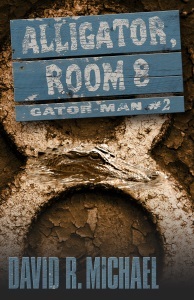 Alligator, Room 8 by David R. Michael
Alligator, Room 8 by David R. MichaelNovella (Gator-man #2)
One year ago, Ash Turner was taken into the swamp, shot in the back of the head, and left for dead.
No longer dead, Ash is now stuck in New Orleans. As the only surviving witness to the “disappearance” of local pillar-of-the-community and suspected crime boss, James Derouen, Detective Marand of the NOPD wants Ash to stay put.
Detective Marand won’t listen, but Ash knows James Derouen isn’t coming back. Not from where Ash saw him “disappear”–down the gullet of an angry alligator god. That same alligator god has twisted Ash’s love for Jamie Derouen, James Derouen’s daughter, into an insatiable need to find her and…
Ash doesn’t want to think about it. He just needs to get out of New Orleans.
Before he can do what he was brought back from the dead to do.
Published by Four Crows Landing.
Available in trade paperback and ebook formats at Amazon, Barnes & Noble, Apple iBookstore, Kobo, Smashwords, and more!
August 21, 2017
The Girl Who Ran With Horses (2nd Edition)
 The Girl Who Ran With Horses
The Girl Who Ran With Horsesby David R. Michael
Novel (2nd Edition)
Excited for summer, Stevie Buckbee is headed home to the family ranch to be with her father, her brother Blake, and her horses. With Jack Rabbit, her first horse all her own, she plans to compete in every barrel race competition in five states.
When she gets to the ranch, though, it doesn’t feel like home. A year has passed since her brother Edwin died in an accident, but Dad is still distant. To make matters worse, Blake has a new girlfriend and plans of his own.
Her horses seem to be the only ones she can talk to. She never expected the horses to talk back…
Published by Four Crows Landing.
Available in trade paperback and ebook formats at Amazon, Barnes & Noble, Apple iBookstore, Kobo, Smashwords, and more!
May 4, 2017
Now Serving Dragon
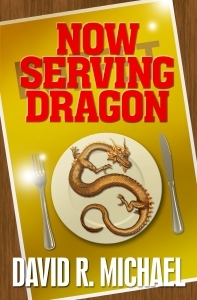 Now Serving Dragon
Now Serving Dragonby David R. Michael
Novel
A Hungry Goddess. The Goddess Queen in Her Kitchen has spent generations Seasoning the World to Her Taste, but She still needs the Final Ingredient.
A Part–Time Dragon. Thara Gold’s rent is due and she needs a new job. Right now, though, she hopes she can make it home before her Episode starts. She doesn’t want to turn into a dragon on the bus.
A Rookie Dragon Hunter. After 6 months living with his mother, Marcus Nelson is willing to consider any job, even joke jobs like “Dragon Hunter – No Experience Necessary!” It has to be a joke, but he needs the work, and the man with the job is expecting him to show up Friday. Unless the World Ends the night before.
Published by Four Crows Landing.
Available in trade paperback and ebook formats at Amazon, Barnes & Noble, Apple iBookstore, Kobo, Smashwords, and more!
October 24, 2016
All Hollows Eve (GoSH4)
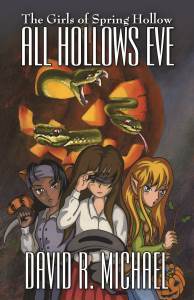 All Hollows Eve by David R. Michael
All Hollows Eve by David R. MichaelNovel (The Girls of Spring Hollow Book #4)
A new witch has come to Spring Hollow, just in time for Halloween.
Halloween is Brenna Guin’s favorite time of year. With her new friends, Faye Woods and Lupe Garcia, plus her new abilities–like being able to see in the dark–this year should be the best Halloween ever. If only her mother would stop ruining it for her.
Two nights before Halloween, sneaking out after dark–alone, because even Norv, her pet rat, refuses to cooperate–Brenna encounters Eve Coronelle, the neighborhood’s newest addition.
Brenna has never met Eve, but she has heard about “that Eve Coronelle” all month from her mother. Ever since Eve moved into the quaint gray brick house on Gingerbread Row, her mother has had nothing nice to say about the woman. Her mother had called Eve a witch more than once.
Turns out, her mother was right …
Published by Four Crows Landing.
Available in trade paperback and ebook formats at Amazon, Barnes & Noble, Apple iBookstore, Kobo, Smashwords, and more!
October 19, 2015
Closing Crew
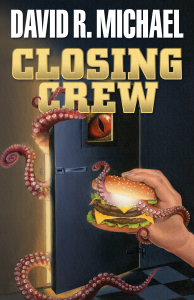 Closing Crew by David R. Michael
Closing Crew by David R. MichaelNovel
Strange things happen when Dillon opens doors. A cold, lifeless universe waits in the bathroom. A hideous creature that looks nothing like a puppy lurks in his closet. He doesn’t remember what was in his toy box, but he still has nightmares.
In his job as night manager at the Buffalo Burger Pit Dillon has found a use for his special gift: hazing the new hires. Like when he offers them a free vanilla shake. Or opens the door of the big freezer for them to see inside.
Soledad has been able to read minds since life hit her with the puberty stick. Not Dillon’s mind, which is probably why they’re still friends. She’s always thought his trick with the vanilla shakes was stupid. She never imagined how stupid.
Published by Four Crows Landing.
Available in trade paperback and ebook formats at Amazon, Barnes & Noble, iBookstore, and more!
June 1, 2015
Alligator Bait (Gator-man #1)
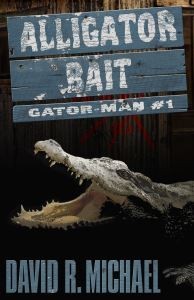 Alligator Bait by David Michael
Alligator Bait by David MichaelNovella (Gator-man #1)
One year ago, during Mardi Gras, Ash Turner was pulled from the arms of his lover, Jamie Derouen, by men working for her father. Those men drove Ash into the bayou, shot him in the back of the head, and left his corpse for the alligators. So it comes as a surprise to everyone–including Ash–when he wakes up in the muddy water of the bayou and walks back into New Orleans.
Mardi Gras is once again underway, but Ash isn’t there for the parades or the parties. He’s looking for Jamie. Nothing else seems important any more.
At the same time, though, there are forces looking for him. A police detective interested in a growing pile of missing persons cases. The men who thought they had killed Ash already. And something else. Something unseen that watches Ash from the swamp.
Published by Four Crows Landing.
Available in trade paperback and ebook formats at Amazon, Barnes & Noble, Apple, Kobo, Smashwords and more!
February 5, 2014
The Wonky Compass
They say a broken clock is right twice a day. I’ve never heard anyone say anything nice about a broken compass that points whichever way, either stuck or pointing at random.
Yeah. I’ve (again) adjusted my ( albeit vague ) plans. Did you see that coming?

Rather than launch into short stories right away, I have decided to pick up a project I started (and abandoned) for NaNoWriMo 2010.
I had planned to reboot this project after Gunwitch3, so it’s not an entirely new plan. Just one that has been shuffled to the front of the deck.
It’s also not a entire reboot. I had written about 26,000 words before I dropped it for reasons I can only vaguely recall. Something to do with thinking the wrong character was the hero. Fortunately, I have since realized that I can let the protagonist continue to be the main character, and just let someone else be the hero. Sorta. It’ll make sense, I promise. Regardless: Problem solved. Especially since that solution allows me to keep just about everything I had written.
A small bonus for this project is that it’s almost completely different from either Gunwitch or GoSH. I think another lesson I can learn from the past 2-3 years is that I require more variety in my writing/creative life than switching back and forth between two series.
I kicked off the reboot Monday by creating a new category in The Journal and extracting the content from my NaNoWriMo archives. Yesterday I read through the outline (what there was of it) and began reading through and editing what I had written.
After a bit of pondering, I’ve decided not to complete the outline, but to let the book grow organically from what already exists. That’ll make the project somewhat experimental/different/challenging for me, as I prefer to outline novels .
Somewhat coincidentally, this is the Nano project that I shelved before picking up an earlier Nano project that I had shelved, which I finished soon after and called Gunwitch: A Tale of the King’s Coven . And now, here I am, picking up this shelved Nano project to finish it.
Maybe that’s a plan I could pursue sometime: Start a bunch of projects, just to shelve them, then pick them up later and finish them. This will make the … third? … time, I think. Yup. At least for novels.
No. I don’t want to make a habit of that, with or without outlines.
Anyway, time to get back to reading/editing/daydreaming of how the story will build and build and build until it ends with a Bang! And, hopefully, more than a few chuckles.

-David
Related Posts:
It Was a Fun StreakOutline to Completed Novel Word Count RatioMy Longest Outline EverAnother Reason I Like How I Outline My NovelsTalking to Myself Blindly in the Dark
January 24, 2014
Actual Licks-to-Chocolatey-Center May Vary

I’ve commented before about how I underestimated how long it would take for my indie writing/publishing to gain traction. Now that I’m closing in on 3.5 years since I indie published my first short story (“Nostalgia”), I will now say I have understated just how much I underestimated.
Which was a lot.
So far, 2014 looks a lot like I’m starting over. Or like I never started. Or like maybe I forgot to hit the “Start” button in the first place? (Pauses to check “Start” button. Nope. That sucker is pushed.)
I thought I would have made it further from the starting line by now, but … No. Not so much. Evidently 1 million words spread across 9 novels and lots (dozens? dozens of dozens?) of short and short short stories is more of a General Admission ticket. Less of a box seat. Still lots of room for doing more.
I try to avoid feeling like I’m standing still. Because I’m not.
The motion is slow, I guess, but it’s motion. I’m moving.
With that in mind, I’ve decided to change my pace a bit for 2014. At least for the first few months. Maybe through the summer.
I’m going to write some new short stories. My first since early 2011–which seems impossibly long ago. It’s hard to even imagine going 3 years without writing a short story. I love short stories! Reading them, and writing them. I guess I got focused on novels–and got caught up in all the presumed excitement of indie publishing.
Anyway, besides writing new short stories, I’m going to be submitting those stories to paying markets. Submitting stories like this will be a new experience for me, but one I’ve been meaning to tackle for a long time. If a market picks up a story, that’s great. If not, I can figure out something to do with it, I’m sure.
The general goal is to write a short story each week, then get that story into the mail/submission process the week after. And just keep doing that for a while.
I’m not sure if I’ll keep up the short story writing until I sell something to a magazine, or until I feel the urge to take on a novel again (there are GoSH and Gunwitch books left to write). Or just … whatever. Hell, I’m not even going to promise that any given story I start won’t run long. I might end up with a totally unexpected novel. Which would be cool. Like I said above, this more about a change of pace. Doing “something different.”
After 3 years, I need a change. And I’m gonna be that change.

-David
Related Posts:
It Was a Fun StreakMy First Full Year as an Indie Author9 Months of Indie Publishing – Ebook Pricing Addendum9 Months of Indie PublishingShort Story Ebook Economics



